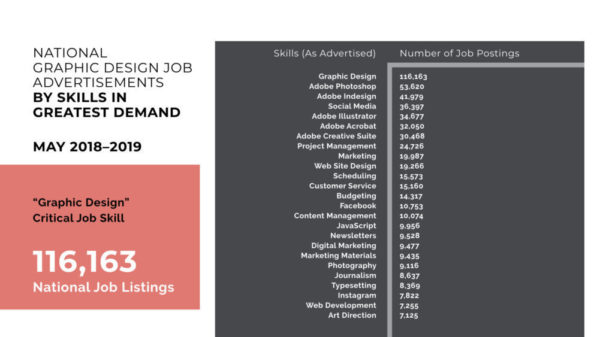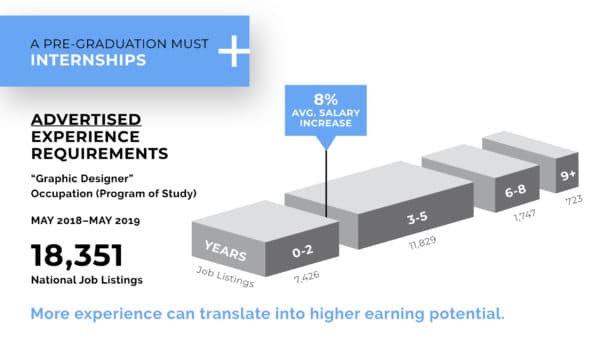This article was contributed by Nancy Miller, Assistant Professor of Graphic Design at Texas A&M University.
As an academic teaching graphic design, keeping up with the ever-evolving shifts in technology and forecasting occupational trends in professional practice can be overwhelming. Compounding the goal of staying current to best serve students is the awareness of the over-saturation of entry-level designers in the applicant pool.
To answer the modern graphic design student’s demand for return on their educational investment, university staff must make a deliberate effort to groom their students to be competitive job candidates with relevant skills and applicable competencies.
In a discipline where strategy, creativity and technology must be planned and implemented into all phases of the curriculum, integration of the pragmatics of real work cannot be neglected.
Ensuring Graphic Design Graduates Are Employable
Occupational Trends in Graphic Design
To truly understand the employment landscape that graphic design graduates will enter into, design educators must apply real-time labor market data on employer demand to their understanding of the present-day job market. Without reviewing up-to-date job listing requirements, we are only guessing about what employers are looking for in candidates.
Below, a series of recent labor insight reports secured with Burning Glass Technologies’ proprietary database on career areas and corresponding occupations for graphic designers was used to determine the skills and competencies that employers are seeking.

Source: Author’s calculations using propriety data from Burning Glass Technologies, 2019; and Bureau of Labor Statistics, Occupational Employment Statistics, 2019.

Source: Author’s calculations using propriety data from Burning Glass Technologies, 2019; and Bureau of Labor Statistics, Occupational Employment Statistics, 2019.
Two data sets of national (U.S.) job listings from May 2018 to May 2019 were examined, Graphic Design specific jobs, which yielded 28,877 job listings, and a more expansive data set of job advertisements that list graphic design as a critical/required skill, which yielded 116,163 results.
As visual communication and creative skills become more prevalent in other fields, many students will use their graphic design qualifications to satisfy job opportunities in a variety of careers. In both data sets, over 80% of the job listings called for a bachelor’s degree.
With so many alternative learning tools and platforms claiming to teach mastery of graphic design and related technologies, this strong preference for, or the requirement of, the bachelor’s degree validates the importance of a formal education for today’s prospective graphic design student.

Source: Author’s calculations using propriety data from Burning Glass Technologies, 2019; and Bureau of Labor Statistics, Occupational Employment Statistics, 2019. Note: This report provides information on both the preferred and minimum/required education levels listed in job postings. For this reason, a job posting may be counted in more than one of the educational categories shown above.

Source: Author’s calculations using propriety data from Burning Glass Technologies, 2019; and Bureau of Labor Statistics, Occupational Employment Statistics, 2019. Note: 75% of records have been excluded because they do not include salary information. As a result, the chart above may not be representative of the full sample.
2. Aligning Curriculum with Labor Market Demand
As a discipline tied to technology, the nature of graphic design is ever-evolving and today that evolution is happening at a more accelerated pace than ever before.
Adopting real-time job data for examining the labor market will help academics keep their finger on the pulse of the expanding industry. After identifying which skills employers are calling for, we must align our curriculum to connect knowledge with competitive jobs. This intentional preparation of students builds in-demand design programs with high growth potential that ready graduates for their future.
Based on analysis of the data sets above and the definitions of the outlined skills from Burning Glass Technologies, the table and chart below align the requested skill to its most common industry standard graphic design software application.

![]()
Source: Author’s calculations using propriety data from Burning Glass Technologies, 2019; and Bureau of Labor Statistics, Occupational Employment Statistics, 2019.
Proficiency in Adobe Photoshop, Illustrator, InDesign and Acrobat are expected. As social media continues to rise in importance to companies, students will need to stay abreast of changes with popular social networking sites in order to constantly appeal to users and engage audiences across the board. Behind social media design, knowledge of marketing fundamentals, interactive user design and motion design are also critical to applicants in setting them apart and making them more competitive in the candidate pool.
It is expected that some educators will take issue with the listing of software applications as “skills.” After all, most seasoned graphic designers consider these applications to be mere tools, not skills or competencies, citing creativity and conceptual strategy as the true keys to success in the field.
Yet, it is important to note that many job postings do list technologies or software applications as “skills.” We must derive competencies from a job market articulating demand in terms of software. We must also acknowledge that without proficiency in industry standard applications, for the professional execution of ideas and completion of design process tasks, students cannot hone true strategic competencies such as creative problem solving, visual communication and the parsing of information.
In the table below, I have associated the advertised required skills with relevant competencies that are standard to the creative field.

Source: Author’s associations of creative industry relevant competencies to national job advertisements by skills in greatest demand using propriety data from Burning Glass Technologies, 2019; and Bureau of Labor Statistics, Occupational Employment Statistics, 2019.
The findings confirm that the labor market expects the modern graphic designer to be multiskilled in both technologies and competencies to seize career opportunities. The prevalence of strategic and organizational skills cannot be ignored. Project management, budgeting and scheduling were listed as common job requirements. This diverse student training of design-oriented capabilities, social media knowledge, new technologies and strategic management must be built upon a foundation of creative problem solving and visual communication.
Local Market Alignment
Beyond national labor market data, educators and administrators should consider the formation of an advisory panel, comprised of experts and professionals in the field, to help guide curriculum, instruction and assessment of design scholarship offered. If program graduates commonly feed a local workforce, an advisory committee with representatives from respected placement companies and organizations can be especially conducive to providing insight for fostering employable students by establishing workplace requirements and expectations in a talent pipeline.

3. Student Development and The “Real-World” Experience
Exposure to Creative Industry Professionals
The professional development of students goes beyond alignment of curricula to careers. It requires crafting the student’s experience, not just their learning outcomes.
Fortunately, in graphic design, student exposure to creative industry professionals and cooperative learning practices is achievable. One simple networking strategy is to invite experts from the field to be guest lecturers in the classroom. Hearing about real-time, real-world matters makes students aware of the latest issues affecting creatives working in the industry. Instructors can steer the knowledge that students will take away from these lectures by suggesting discussion topics that are significant to course learning outcomes or class projects.
Beyond speaking engagements, academics should ask professionals to serve on review panels for course assignment presentations. In this setting, the oral and written feedback offered is largely informative to the student’s understanding of the success or failure of their proposed project solution.
Outside of the classroom walls, educators can broaden student knowledge of the real-world of work by coordinating on-site tours of vendor facilities related to the field or of appropriate professional job sites. For many students, seeing the inner workings of an in-house marketing department, a specialty studio or a full-service advertising agency helps them to realize their career goals and to draw connections to the field.
Work Experience
The aforementioned strategies can develop introductory interactions with professional individuals, companies and environments, but implementation of hands-on, service-learning opportunities which mimic real-world work flows are crucial for deeper learning in graphic design scholarship. It is in these client-environments that students practice and refine soft skills such as communication, organization and teamwork, all of which are crucial to career success.
Designing courses with work experience, or service-learning, projects drives student to apply imaginative creative strategy in response to client needs and/or business goals on a case-by-case basis. This format is the most intensive agility training that graphic design faculty can provide for their students.
The acquisition of clients for service-learning can be achieved through alliances with small business, entrepreneur and other professional organizations. In the projects forged from these partnerships, students can work independently or in groups with business owners, acquiring project management, budgeting and scheduling skills in addition to relationship cultivation through the articulation of ideas and response to the clients’ needs and goals. These experiences are dually beneficial. Students gain valuable experience through professional practice, and graphic design programs establish partnerships and community ties with service-learning participants.
Internships
Design-centric internships provide ongoing, work-based, practical opportunities for learning and should be required as part of the modern bachelor’s degree plan. In addition to the service-learning perks gained, internships can help students fill minimum experience quotas outlined in the majority of graphic design job postings. More experience can translate into higher earning potential.
In the previous data set of national job advertisements for Graphic Design specific job listings, 18,351 jobs listed a minimum experience requirement, with 34% wanting a minimum of 0-2 years and 54% wanting 3-5 years. Advertised starting salaries from these listings increased an average of 8% at the 3-year minimum experience mark.

Source: Author’s calculations using propriety data from Burning Glass Technologies, 2019; and Bureau of Labor Statistics, Occupational Employment Statistics, 2019.
Be an Ambassador
To forge partnerships that yield both service-learning projects and internship placements, university staff must take an active role as ambassadors for their programs. They should speak to local organizations and overtly advertise their service-learning opportunities on public-facing information outlets, such as program websites or social media networks.
All channels should promote the added value that professional design can bring to any organization through available no-cost service-learning projects or arrangements. The security of the instructor-guided format and the incentives to the student (mentors, job-ready skills and course credit) should be touted. Faculty can lean on institutional career services resources to distinguish any university-led incentives available such as intern pay supplementation programs, available scholarships and job listing portals which might entice companies to participate. Seeking student worker opportunities, internal to the institution, is also suggested. Practically all educational institutions have several in-house departments that can benefit from professionally executed promotional materials created by student designers.
Conclusion
As students place more importance on employment in mapping out their educational experience, we can maximize the value and relevance of our graphic design programs by asserting consideration of student success in occupational advancement post-graduation. Faculty must take an active role in communicating employer needs and professional opportunities to students throughout their college careers. We must look inward to ensure that we are offering ample learning of current and relevant skills, providing platforms for professional development, reflecting on ever-evolving job demands and implementing changes in our curriculum to align with them.
_
About the author: As Program Coordinator and Professor for the Graphic Design program at Texas A&M University, Corpus Christi, Nancy Miller is passionate about the success of her students. With previous roles at Nike and Burton, her primary goal as an educator is excellence in career preparation for her students.
No comments:
Post a Comment